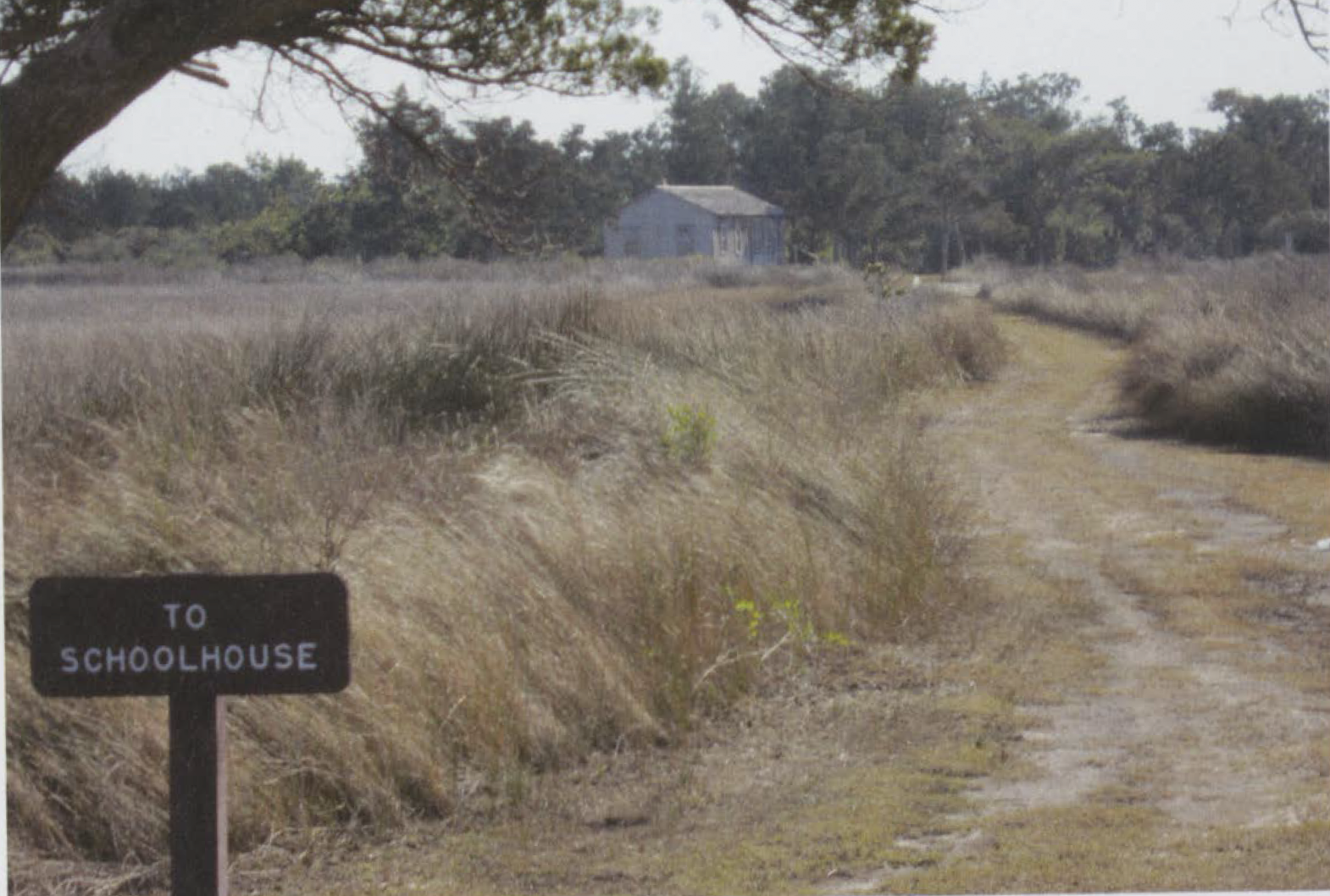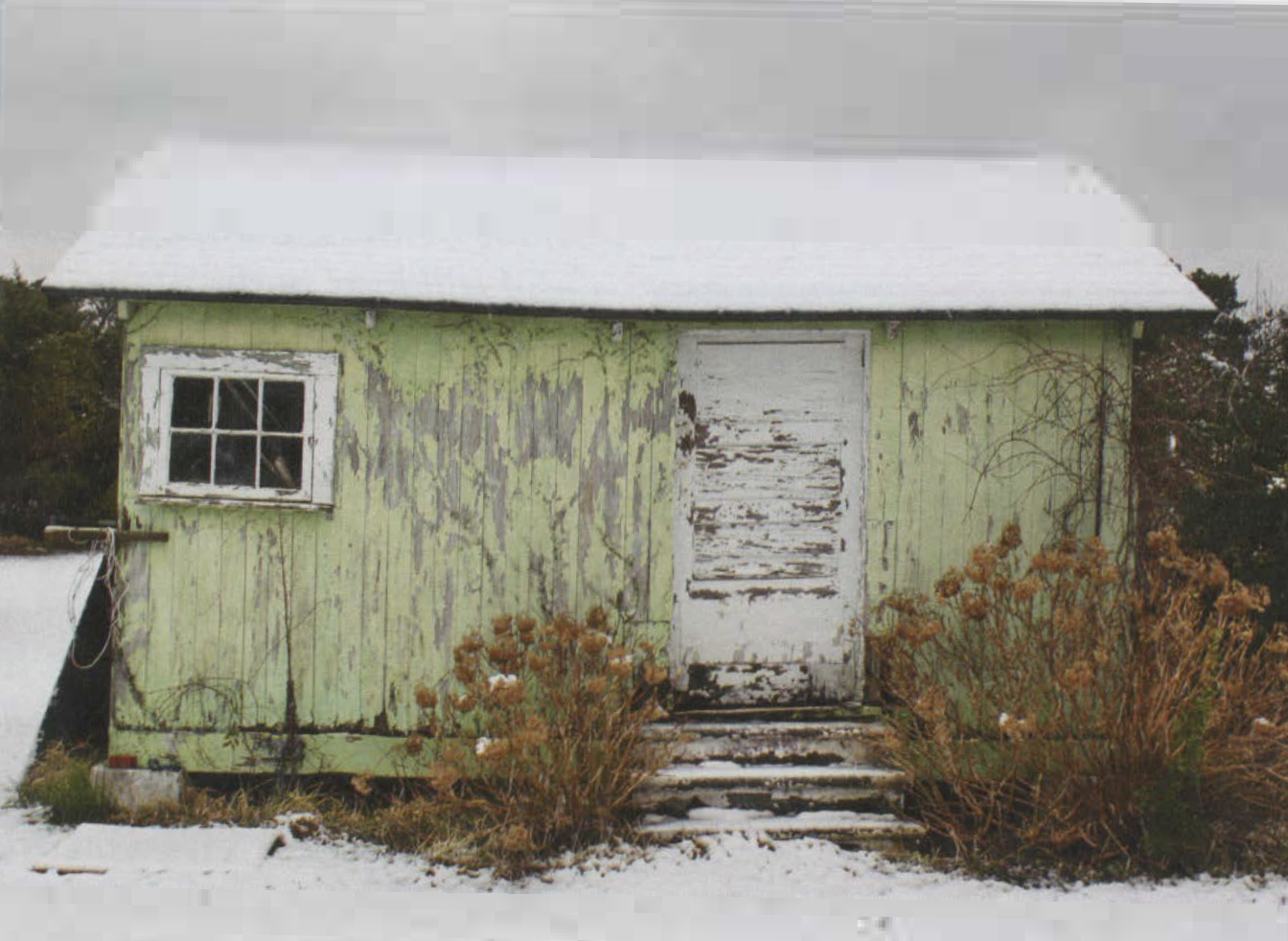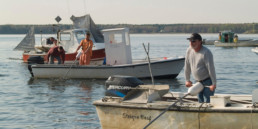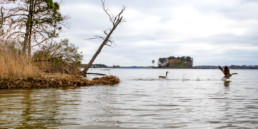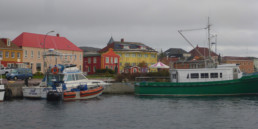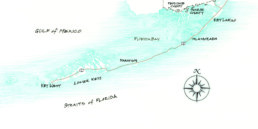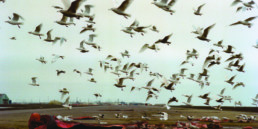Salvage and Regeneration
Stories of adaptation and loss from two barrier islands
By Rob Snyder
I am going to start in the middle of two extremes, exploring what holds one island community together while another becomes a shadow of the past.
David Thomas, a fisherman from Little Cranberry Island and I are heading to Portsmouth Island, one of North Carolina’s Outer Banks, skimming across the top of the water at 15 knots in a flat-bottom boat.
We bear northwest out of “the creek” on Ocracoke Island with Rudy Austin at the helm. He is assured and relaxed, much as his father Junius would have been in the 1950s and ’60s, when he ran people across to the Portsmouth hunting and fishing club. It is a quick crossing, 20 minutes or so.
Through the crisp winter air we pass duck-hunting blinds, family-managed pound nets, and, on Casey Island, just off of Portsmouth, we pass a camp for fishermen who are “hiding from the wife” as Rudy puts it, laughing as if speaking from experience. We cross Ocracoke Inlet, with Pamlico Sound to starboard. Beneath us the shoal waters shift with the tides, while on the horizon a place frozen in time comes into view.
Earlier in the day David and I had anticipated what it would be like to experience an island whose community had changed dramatically-from a year-round island population to a place preserved because it “hearkens back to a simpler time” It made us uncomfortable, yet we were both eager to experience the place- David, as someone who has spent much of his life working to keep his island community vibrant, and myself, a “professional outsider” dedicated to supporting island communities- the perfect pair for this dystopian tour.
From the water Portsmouth appears archetypal, with its church steeple rising up above the red cedars, and 20 or so early-20th-century homes standing against the wind and tide. This barrier island was incorporated in 1753 and was sustained by an economy based on fishing and lightering work. Tall ships would unload to shallow draft vessels, allowing the movement of goods ashore to the Carolinas.
Chester Lynn accompanies David and me when we step ashore on Portsmouth. Chester is an Ocracoker, a descendant of Portsmouth residents and historian of the island. He is a steward of the community’s history, celebrating the continuity of this place over time. Lynn’s personality matches the large shadow that he casts while making his way slowly across the island with the assistance of a cane.
I am struck by the National Park Service’s welcome: HISTORIC PORTSMOUTH VILLAGE-NORTHERN CORE BANKS, CAPE LOOKOUT NATIONAL SEASHORE. It really exists—a place that celebrates what year-round island living used to be like. A neatly manicured path leads us toward a high spot, a few feet above sea level on the Sound side of the island, where the small white post office faces out on an island cemetery and Main Street beyond.
The Civil War took its toll on the island, explains Lynn as we walk. Portsmouth’s population had peaked at 800 residents, including 100 or so slaves, prior to the arrival of northern troops. The war drove the population down to around 300 by the 1870s.
A revival of the community seemed in hand with the construction of a U.S. Life-Saving Station in 1894. However, the closure of the station in the 1930s was a major blow to the community. Its brief reopening around World War II only slowed the community’s eventual demise.
The population had fallen to little more than a dozen residents by the 1950s. The school closed in the mid-1950s, and the post office followed suit in 1959. By 1970 only three residents remained on the island, and they left in 1971. By this time most of the houses in the community had become seasonal hunting lodges or summer homes that people leased from the government in exchange for upkeep.
Portsmouth Island became a part of the Cape Lookout National Seashore in 1976. By the 1980s historic preservation of a range of island structures began. Today the post office is filled with interpretive exhibits of the island’s history. The work of Lynn and others with the Friends of Portsmouth Island informs the educational panels hung around the building.
Standing on the steps of the post office, one cannot help but notice a post just off to the left noting the high water-marks from various storms. Hurricane Isabel is the highest of those recorded. It came ashore in 2003 and its mark stands about four feet above this high point on the island. A thought crosses my mind of being in the storm and looking out a second-story window from one of the perfectly preserved homes, wondering if the house will stay on its foundation, and if the water will ever recede.
Across from the post office a sign invites me to the schoolhouse, an acknowledgment of both the importance of schools to year-round island communities, and an appeal to our fascination with one-room schoolhouses. Maps of the United States, Europe, and the world hang on the walls; perhaps they are artifacts of 1940s geography lessons. The maps remind me of how different the world looked just 70 years ago. The woodstove in the middle of the room is a reminder of the work that would have been necessary to sustain daily life-importing logs, hauling them from wharf to school, and chopping them to feed the fire.
A path connects the school to the beautifully preserved lifesaving station at the east end of the island, providing an opportunity to stroll past homes preserved nearly as they were when the last residents left. But this place has no heartbeat. Unlike a year-round island, this place has no pulse. It feels eerily dead. Today Portsmouth lives on in increasingly distant memories; it is now celebrated only for its role in history, when descendants gather for biennial homecoming events.
I am struck by what we lose when island communities die. They did not build walls to hold back the sea, yet a community thrived here for nearly 200 years. I want to know what Portsmouth islanders knew about how to live with the environment. A way of life certainly resided in the embodied knowledge of Portsmouth’s residents, a type of knowledge gained through repeating the mundane activities of everyday life, day in and day out, passed down through the generations. All of this is now lost.
The continuity of place in Portsmouth is now broken, frozen in time and place for visitors to interpret through the eyes of the National Seashore.
As we skim across the water back toward Ocracoke, Rudy reflects without prompting, “When they start recording how I talk, the stories I tell . . . I wonder if it isn’t already too late.” Perhaps he is thinking about the work he has done to help preserve Ocracoke’s fishing heritage. Although Rudy runs tours to Portsmouth, he and his sons are fishermen, and they are working hard “to keep [ Ocracoke’s] fishermen off of the endangered species list.”
PRESERVING A YEAR-ROUND COMMUNITY
Back on Ocracoke later the same day, we head to the Working Watermen’s Exhibit, a 1930s fish house that has likely been floated from place to place around the creek over the past half century before finding itself home to a celebration of the island’s fishing heritage, past and present. It is not a large place; in fact, you can take it all in upon entering. David and I walk into a room full of 20 or so community members and a whole lot of homemade desserts.
Back in the far-right corner a woodstove has been fired up to take the chill out of the air, and Gene Ballance offers us cups of piping hot cider from the top of the stove. Gene is a mild-mannered Ocracoker and noted math whiz who runs the Working Watermen’s Exhibit and represents the island as a Hyde County commissioner. He is also responsible for one of the more striking exhibits adorning a full corner in the room: a series of maps outlining a 100-year- old snapshot of Pamlico Sound Oyster Harvesting.
On our way through the room we meet the school principal, a real estate broker, new year-round residents, representatives from multigenerational families, and fishermen both young and old. They are here to discuss the future of their island at the invitation of the Ocracoke Foundation and Alton Ballance.
The Ocracoke Foundation is a nonprofit organization that was founded in 2006 in a partnership with the 30 or so full-and part-time fishermen on the island. The fishermen’s goal, which the Foundation successfully supported, was to save the last fish house on the island. Because of this partnership Ocracoke’s Working Watermen now have a storefront, a working wharf, and a co-op structure that will enable them to access the water in perpetuity.
Alton and his brother Kenny represent about the sixth generation of Ballances on the island (Gene is their cousin). Alton is not an elected official-at least, not anymore. He was North Carolina’s youngest county commissioner when he was first elected to office, but that was over 25 years ago now. I found that whenever I would ask who was working hard to ensure a vibrant future for the Ocracoke community, today’s elected leaders would whisper and point to Alton behind his back. A back filled with arrows- the true sign of a leader.
The issues of the evening are fisheries politics and year-round housing. Sea turtle regulations threaten to shut down the summer gill-net fishery, precisely the fishery that feeds local, wild-caught fish to the one million or so summer visitors to the island. Adding to the discussion, David shares the challenges we face in Maine dealing with the northern right whale. There is a common bond in this discussion, and while there are no easy answers, the Foundation is keen to understand how they might organize to support the local fishermen in these debates.
The school is thriving with 132 students in pre-kindergarten through 12th grade, but a number of teachers are retiring. They came to the island back when homes were affordable for the island’s workforce. Island homes currently average in the mid-six-figure range. Teachers coming to the island today can’t afford to buy. David and I are asked about what types of housing efforts are under way on Maine’s islands, and how we structure housing programs that are not tied to national affordability standards. The Foundation is exploring how they can work with realtors and others to solve a problem that extends to other workforce needs, such as park service personnel, ferry operators, and the like.
These issues resonate with David and me, as Maine’s yearround island communities struggle with similar issues. The meeting at the Working Watermen’s Exhibit speaks to how healthy communities grapple with emerging threats to their survival. Later that evening, over a beer in Alton’s kitchen, he ties Maine and North Carolina’s islands together, noting, “The ocean doesn’t divide our islands- it connects them”
Familial connections and commitments to place run deep on Ocracoke. They are brought to life through a range of stories that place today’s challenges in context. In order to access these stories, we have to move back in time, but only just a day.
WHEN YOUR SHED FILLS UP, BUILD ANOTHER
The day before my trip to Portsmouth Island, Alton shows me around his family home. “My dad built this shed” he says while pulling open the worn white door to a faded green shed behind his house. Upon entering it is clear from the smile on his face that he is still amused at what he finds inside. He shows me an old clam rake, handle missing-just the rusted out fingers ready to dig again if there were only time to fix the rake. But there isn’t, because Alton is looking for something specific. He grabs an old duck decoy, handcrafted by a friend his father’s age. I look around and notice stacks of spare pieces of wood running through the rafters, pieces of rope strung from nails. There is so much stuff that it’s hard to move around, but he wants us inside, to take it all in.
“When my dad filled up this shed,” Alton says, “he did what everyone on the island does- he built another one.” He gestures to a second, less-dilapidated shed farther back on the property. We enter the second shed, equally packed with stuff This time he finds what he is looking for: an old gill net still coated in lime, a relic of his dad’s fishing days. He cuts off a piece to carry with him. Then he holds up a black bag and asks us to guess what it is; after a few misguided guesses, I vocalize what I hope it isn’t- a body bag.
A great storyteller, Alton recalls how his mom woke him one morning because his dad was fishing gill nets in Pamlico Sound, and a man had passed away at a local hotel. At this point David knowingly adds for my benefit, “Someone on an island has to be responsible for getting dead bodies off an island.” Alton continues, “My dad was away, so it was my responsibility. I had a friend sleeping over, so I woke him up and told him I needed help moving something” We laugh. It turns out that they found themselves attempting to lug a huge man’s body down the stairs of a hotel while one officer comforted the man’s girlfriend and another called to notify his wife. When they got to the next island over, Hatteras, all the undertaker wanted to know was how Alton’s father had gotten his hands on such a nice body bag.
Beyond the humor of the story we learn something about living on islands, of holding on to things in case they are needed again; a story of living with scarcity. When one shed fills, you build another. In fact, Alton had just built a third shed on his property because the two his father had built were full.
He tells how one of his neighbors, Fowler O’Neal, had a record four sheds, one built right onto the back of the next. One day Fowler wanted to get a pedal bike for his grandson and he knew right where to find one; unfortunately, it was buried deep, a couple of sheds back from the entrance. The answer: Cut a hole through the roof of the shed above the bike and extract it. A different time, a plumbing part that could not be found anywhere on the island was right where another islander had left it- in the trunk of a car buried in the backyard. They dug it out and then reburied the car.
SCARCITY AND SALVAGE
Stories of scarcity and salvage are interwoven with the ways that ships quite literally became a part of the fabric of the island community. Shipwrecks are today the stuff of legends on Ocracoke. The beams of a home that came from tall ships, pounds of nails, furniture-all that a shipwreck offered up would be salvaged by the islanders.
As we walk from the church to the school, Alton notes that the cross in the church came from a shipwreck decades earlier. “They always told us that pallbearers would drop a casket if someone yelled ‘Shipwreck!’ in the church” he says with a smile.
A photo of the three-masted schooner NOMIS underscores this salvage ethic. The schooner ran ashore at Hatteras Inlet on August 16, 1935. Resting on the beach, the hull of the NOMIS is visibly shattered in three places. At midship the gunwale and hull are dismantled, presumably for easier access to the payload. A wreck commissioner would have overseen the salvage, watching over dozens of Ocracokers that arrived to gather what they could. In the picture men are moving from ship to shore hauling wood via a makeshift dock built on-site for the occasion. The wood from the wreck is now a part of island homes, and it is said that some members of the community used a portion of the wood to build crude benches for the outdoor congregation of the island’s then newly organized Assembly of God Church.
Everywhere we go, we hear stories of salvage. At a bedand-breakfast undergoing some renovations, we learn that the newly built island in the center of the kitchen has a story: The legs were from a shipwreck, and the sides from the wooden floor in the decommissioned Coast Guard Station. The solid oak front door on another house comes from the same station. Before the age of recycling, salvage was de rigueur.
Stories of salvage and renewal on the island are wedded with respect for natural processes. Sitting in Alton’s dining room he teaches something more, this time about life and death, and living with nature on the island. His mother was born in the front room, and she died in his arms in the dining room where we sit. This was important to her, and to Alton-that the cycle of life would be completed in this place.
I ask about storms. How do people get off the island? He laughs, having certainly been asked this question many times before. “Most people don’t leave in storms; they stay. There is nowhere else you would want to be. You never know when you will be able to come back if you leave.” This surprised me coming from someone whose job it was as county commissioner to ensure the orderly evacuation of the island during hurricanes.
He recalls a storm where “it almost came to pulling plugs.” I thought I had misunderstood what he said. Alton explained that older houses on Ocracoke were built as far as possible from the open ocean. On Ocracoke the historic housing is on the Sound side of the island, around the creek. Houses were built on top of large tree stumps, and loadbearing timbers often came from shipwrecks. The storms would come as they always had, so they designed ways to keep houses from floating away.
Pulling plugs is a very literal turn of phrase. Older houses on Ocracoke have large holes in the corners of their floors with cork plugs in them. When storms come through, Alton decides if it will be necessary to pull these plugs. The Ballances and others who have inhabited the islands for generations realize that the way to stay on the island is to let the water in and through the house. Open the front and back door, open any trapdoors, pull the plugs, and let it through.
This knowledge runs in the face of the common perception of hurricanes hitting the Carolina coast. We are fascinated with media images of four-story summer homes barely holding ground as they are inundated by wave after wave. Yet Ocracokers, rather than fighting storms, live with them. They don’t leave; they just move to the second floor of the house and let the storm pass through. How else could you survive for so long in a place where the natural environment is constantly shifting?
The knowledge lost with the passing of Portsmouth Island was still being lived on Ocracoke. I found this knowledge startling for what it said about living with a highly dynamic environment rather than against it.
ISLANDS ON THE MOVE
Alton stops his truck so that we can walk on the beach shortly after our arrival on Ocracoke. He leans down and picks up a smooth gray oyster shell. He encourages David and me to do the same, and then tells another story, one that I later found in the introduction to his book, Ocracokers. We look at our shells as he recounts how the barrier islands of the Outer Banks are on the move. They have been moving landward since the beginning of time.
A geologist, Alton hypothesizes that while moving landward, the sand dunes have run into stationary pieces of land and gotten “hung up” The historic fishing and trade villages on Hatteras and Ocracoke occupy such pieces of land. In other words, the beaches of the National Seashore on Ocracoke may some day break off and become separate islands, leaving the creek and the surrounding community as a much smaller land mass.
Alton pauses after giving some geological perspective to this place. He then points out that the mid-tide oyster shells delivered to the beach on the falling tide do not grow in the open ocean. Instead, the oysters that grew these shells lived in Pamlico Sound, some 3,000 years ago or more. These shells have been buried under Ocracoke all this time, only to reemerge and be washed ashore as the dunes move landward.
To hold the soft worn shell of an oyster from the beaches of Ocracoke is to hold a tacit reminder, juxtaposed against the fate of Portsmouth, of the strengths of this place- of the hard work that goes into retaining a sense of continuity while engaging with change, and perhaps most of all, how important it is for those who live on to share their island culture and history.
Rob Snyder is president of the Island Institute. More information on the Carolina working waterfront can be found at www.ocracokewatermen.org.

